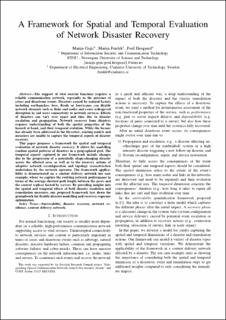| dc.contributor.author | Gajic, Marija | |
| dc.contributor.author | Heegaard, Poul Einar | |
| dc.contributor.author | Furdek, Marija | |
| dc.date.accessioned | 2021-04-22T11:59:29Z | |
| dc.date.available | 2021-04-22T11:59:29Z | |
| dc.date.created | 2020-12-11T08:09:39Z | |
| dc.date.issued | 2020 | |
| dc.identifier.isbn | 978-0-9883045-5-0 | |
| dc.identifier.uri | https://hdl.handle.net/11250/2739147 | |
| dc.description.abstract | The support of vital societal functions requires a reliable communication network, especially in the presence of crises and disastrous events. Disasters caused by natural factors including earthquakes, fires, floods or hurricanes can disable network elements such as links and nodes and cause widespread disruption in end users connectivity to network services. Effects of disasters can vary over space and time due to disaster escalation and propagation. Network recovery from disasters requires understanding of both the spatial properties of the hazard at hand, and their temporal evolution. While the former has already been addressed in the literature, existing models and measures are unable to capture the temporal aspects of disaster recovery.This paper proposes a framework for spatial and temporal evaluation of network disaster recovery. It allows for modelling random spatial patterns of disasters in a geographical grid. The temporal aspects captured in our framework include changes due to the progression of a potentially shape-changing disaster across the affected area, as well as to the recovery actions of adaptive network reconfiguration and topology reconstruction undertaken by the network operator. The framework applicability is demonstrated on a content delivery network use case example, where we capture the evolving network performance in terms of the average shortest path length between the peers and the content replicas hosted by servers. By providing insights into the spatial and temporal effects of both disaster escalation and remediation measures, our proposed framework lays down the groundwork for flexible disaster modelling and recovery sequence optimization. | en_US |
| dc.language.iso | eng | en_US |
| dc.publisher | Institute of Electrical and Electronics Engineers (IEEE) | en_US |
| dc.relation.ispartof | 32nd International Teletraffic Congress (ITC 32) | |
| dc.title | A Framework for Spatial and Temporal Evaluation of Network Disaster Recovery | en_US |
| dc.type | Chapter | en_US |
| dc.description.version | acceptedVersion | en_US |
| dc.identifier.doi | 10.1109/ITC3249928.2020.00013 | |
| dc.identifier.cristin | 1858557 | |
| dc.description.localcode | © 2021 IEEE. Personal use of this material is permitted. Permission from IEEE must be obtained for all other uses, in any current or future media, including reprinting/republishing this material for advertising or promotional purposes, creating new collective works, for resale or redistribution to servers or lists, or reuse of any copyrighted component of this work in other works. | en_US |
| cristin.ispublished | true | |
| cristin.fulltext | postprint | |
| cristin.qualitycode | 1 | |
